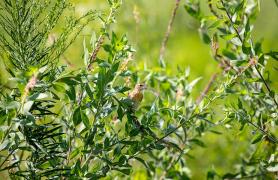For many Missouri families, nature is a way of life. It doesn’t stay neatly in its place outdoors, but spills into the house, into the heart, and right into the holidays. That’s how it is for Jamie Koehler, assistant manager of MDC’s Cape Girardeau Conservation Nature Center. Family traditions that started when she was young are sewn with strength into her daily routine and continued holiday traditions.
“We were always going for long walks in the woods and coming back with our pockets full of treasures like rocks, bones, and nuts,” she said. “The shelves in my room had shells, sticks, and leaves mixed in with the books I was reading, and I could tell you where I picked each one up.”
Koehler remembers making a wreath of pinecones and acorns when she was just barely school age.
“It was suggested I might paint it gold to make it prettier, but I thought it was beautiful just as it was,” Koehler said.
From a Hobby to a Career
This love of nature and creating things has stuck with her, leading her into her current career, and making her the perfect person to lead the Cape Nature Center’s nature décor programs. Koehler teaches how to make wreaths, centerpieces, and ornaments out of natural items.
Before the programs, Koehler and nature center volunteers head to the woods to gather items.
In the spring and summer, they collect flowers to press or dry for making cards and wall décor. In the fall, the colorful leaves are perfect for pressing. But winter has its own bounty for those who know to seek it.
“Winter gets such a bad reputation for a time to be outside, but it is wonderful if you just dress appropriately,” she said. “Admire the structures of the trees without their leaves, the moss, the fungi; there’s still life everywhere and lots of things to collect.”
Koehler uses MDC’s Seedling Order Form (mdc.mo.gov/seedlings) to add more plant diversity to her family’s property. Her main priority is for wildlife habitat.
“However, I must admit, sometimes my plant choices are based on what I can use; whether the plants provide fruit, nuts, or wood,” she said.
Conscientious Collector
She also seeks permission to look for items on other private land and makes sure to share what she finds with those landowners. Also, she looks on conservation areas, where some collecting is allowed for personal use, depending on the area. She cautions people should always check area specific regulations and take care to follow important ethical practices when collecting and foraging. Having permission to access a property is essential, as well as respecting the habitat.
“Be aware of endangered plants and leave them be and never collect all of a single species in an area,” Koehler said. “Always leave enough plants to regenerate or reseed.”
Tips from a Forager
For safety reasons, Koehler said it’s also important to be aware of your surroundings and always be prepared with water, compass, and map.
Nature can be predictable, but often it’s not. Koehler said though she usually has in mind what she’s looking for when foraging, she finds many other unexpected items.
“I think one helpful tactic is to look at the world as if through the eyes of a child. If you can do that, you see beauty everywhere,” she said. “Even broken things have a natural charm and grace. Sometimes I must walk completely around something to see it in a different light or angle. Sometimes I turn it over to see something special.”
So, when out foraging for natural décor items, expect the unexpected and bring tools. A pack for carrying your treasures is probably most important. Koehler brings gloves, scissors or garden snips, and paper bags.
“I also like to carry a journal, so I can take pictures with my phone and record findings,” she said.
When the baskets are full, she doesn’t take them into the house immediately. Instead, she lets them sit outside in the shade for a while “to let all the creepy crawly things vacate.” She also bakes pinecones in the oven a little bit to help them open fully.
Crafting Corner
When it’s time to get crafty, she always has a hot glue gun, florist wire, pruners, and scissors on hand. When crafting with children, there are more abstract tools to have in your toolbox: preparation and patience to ensure the tasks and tools are age appropriate.
“I may do a little prep and assembly myself to make it easier for children,” she said. “Also, remember children’s fine motor skills are still unrefined. You don’t want to give them something they cannot do; that is so frustrating for little ones.”
Another thing to keep in mind is that it is their project, not yours. If it doesn’t look like the picture, that is just fine. “It is a work of art just as it is,” she said. “The only limit is the imagination.”
Koehler creates floral arrangements for holidays and ordinary days. Natural items can be added to a mantel, over doorways, porches, or stair railing in the forms of garlands or swags. She also cautions not to get caught up in perfectionism.
“The process of creation is vital to all of us, it just manifests differently,” she said. “I like that I can never do it wrong. It is mine, so it is right.”
Centerpiece Instructions
Basic Materials: hot glue gun, florist wire, natural items
- Collect materials and tools in a space where you can make a mess. Because you will.
- Start with a base of some sort. A tree cookie was used for this project, but driftwood, stone, or even whimsical things like boots or mittens could be used as a base.
- Identify the three parts to your arrangement. There should be a ”thriller, filler, and a spiller.”
- Start with your ”thriller.” This is one or two showy pieces. Secure them to your base using hot glue or wire if they don’t sit naturally in the base.
- Next, apply the ”filler” to fil lout the rest of the arrangement with smaller or less colorful objects. Don’t let them outshine the thrillers.
- Then ground the piece with something that spills out over the edge.
- Another major rule to obey is ”less is more.”
- Then spend some time moving and rearranging. Add or take away as needed until you are happy with the arrangement.
- Make sure everything is secure and will stay put. One of the disadvantages of natural items you should be aware of is that sometimes things will shed or fall apart. Sometimes a shot of hair spray can keep things together a little longer. You may have to keep tidying your arrangement
Cardinal Pinecone Ornament Instructions
Materials: pinecones, red paint, felt, glue or hot glue gun, small wooden bead (about an inch in diameter), black marker, string
Prep: You may want to cut beaks and wings out of the felt in advance to make the project easier for very young children.
- Collect pinecones. This is a great place to start a project with children. Let them pick up pinecones on a walk and then they’ll be able to complete the project from start to finish.
- With a small paint brush, paint the pinecone and bead red, like the body of a cardinal. Then let the paint dry.
- While the paint is drying, cut wings and beaks out of the felt.
- Position the wings on either side of your pinecone and glue them on. Then, fold the felt beak pieces and glue them onto the face of your cardinal.
- Use the black marker to add eyes to the bird.
- Glue the head to the pinecone.
- Loop a 6-inch piece of thin string and use the hot glue to fasten onto the back of the bird, making it an ornament.


















Also In This Issue


And More...
This Issue's Staff
Editor - Angie Daly Morfeld
Associate Editor - Larry Archer
Staff Writer - Bonnie Chasteen
Staff Writer - Heather Feeler
Staff Writer - Kristie Hilgedick
Staff Writer - Joe Jerek
Art Director - Cliff White
Designer - Shawn Carey
Designer - Les Fortenberry
Designer - Marci Porter
Photographer - Noppadol Paothong
Photographer - David Stonner
Circulation - Laura Scheuler






















